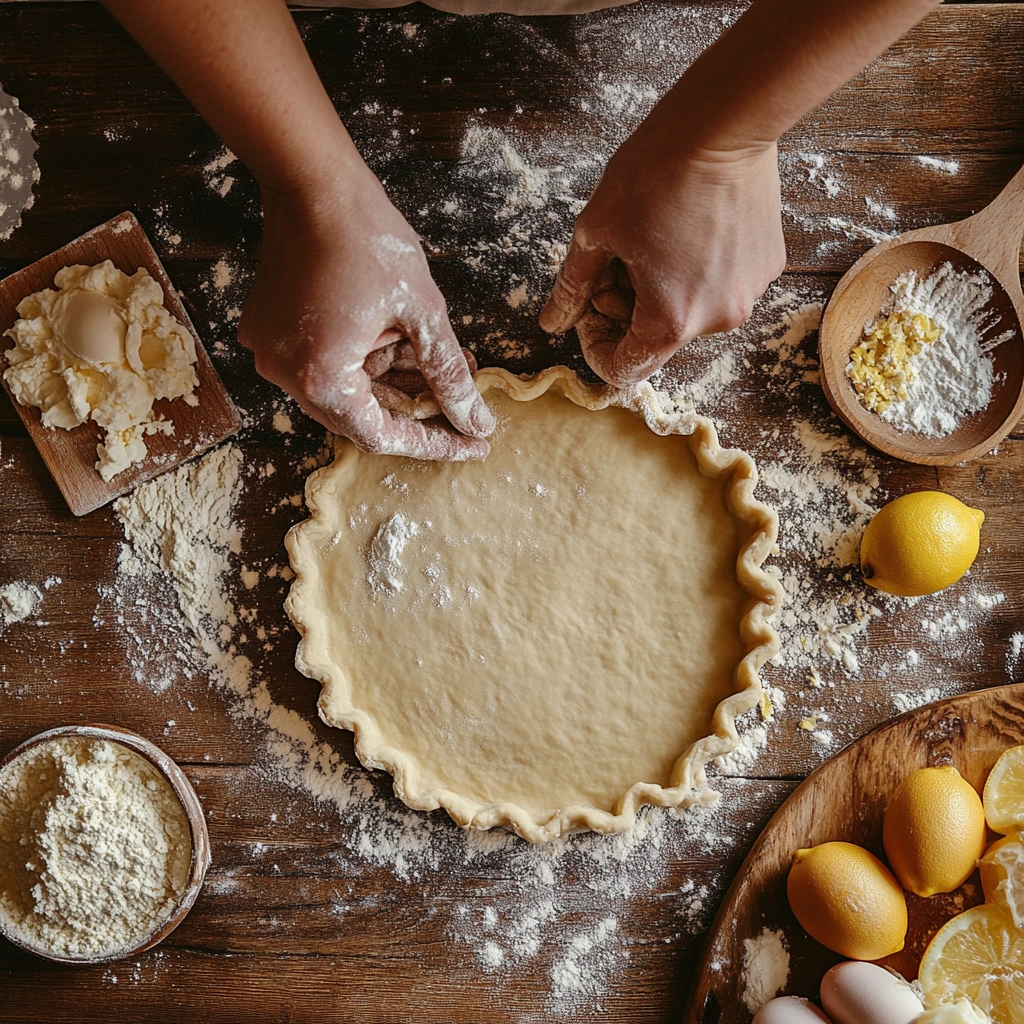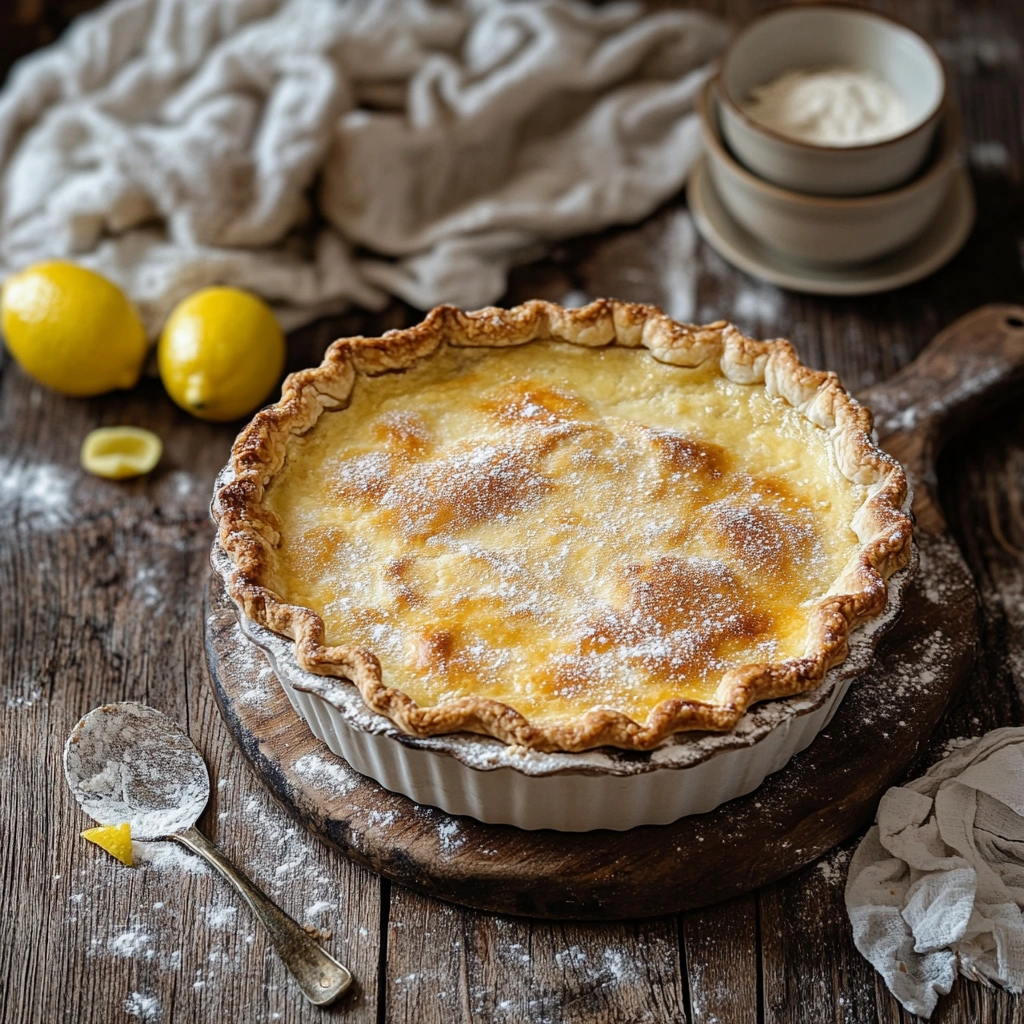Imagine biting into something so creamy and delicate that it almost whispers tales of old-country kitchens. This ricotta pie recipe is much more than a dessert; it’s a cherished tradition that evokes images of bustling family gatherings, sunlit markets, and rustic wooden tables. Though many treat it like an indulgent sweet perfect for special occasions, it need not stay confined to holidays. In fact, it can easily take center stage at any ordinary weekday meal, brightening up your kitchen with a taste that’s equal parts elegant and comforting. Moreover, you can tweak this dish to reflect personal preferences, ensuring it becomes a household favorite. Before learning how to craft this exceptional treat, let’s start by exploring its roots, its flavor components, and the reasons that make it stand tall among many Italian-inspired sweets.
Part 1: Understanding the Ricotta Pie Recipe
What Is a Traditional Ricotta Pie?
A traditional ricotta pie is an iconic Italian dessert that combines creamy dairy goodness with subtle sweetness. Although typically associated with certain festivities, this dish can appear year-round, delighting those who appreciate authentic flavors. The filling, set in a pastry crust, gently balances richness and freshness. When you slice into it, you’ll find a texture resembling a tender custard, yet firmer and more nuanced. By fusing together milky softness, mild sweetness, and hints of citrus, it creates a treat that transcends mere pastry and stands as a testament to time-honored baking craftsmanship.
Cultural and Historical Background of Italian Easter Pie
Though Italians enjoy many desserts, the Italian Easter pie holds a dear place in traditional culinary lore. Generations of families have shared cherished recipes, and no two might look precisely alike. Originating in Southern Italy, where making fresh cheese and desserts from scratch remained common, this delight spread through Italian-American communities. Over decades, it carried stories and memories across oceans, turning ordinary meals into delightful feasts that linked past and present. Indeed, it symbolizes comfort and continuity, unveiling how one dessert can both embrace change and honor its roots.
Key Ingredients and Their Roles in a Creamy Ricotta Dessert
At the heart of a creamy ricotta dessert sits, of course, fresh ricotta cheese. This remarkable ingredient delivers milky depth, while sugar lends subtle sweetness. Furthermore, eggs add structure and a gentle richness. Often, lemon zest or vanilla extract brightens the flavor, introducing lively aromatic notes. Meanwhile, a simple pastry crust, created from flour, butter, and water, encases the filling and offers a delicate counterbalance. By carefully selecting quality elements—using premium ricotta, fresh citrus, and top-notch flour—you ensure the outcome boasts pure authenticity.
The Importance of Fresh Ricotta Cheese
Although you can buy ricotta easily, not all varieties taste the same. Indeed, fresh ricotta cheese elevates the whole experience. Instead of relying on packaged, watery options, consider straining or making it from scratch. Properly drained and creamy, fresh ricotta yields a luscious filling without grittiness. Beyond flavor, its consistency matters. High-quality ricotta holds its own, resulting in a velvety interior that won’t weep or separate. Ultimately, embracing better ingredients can transform your dessert from merely good to utterly unforgettable.
Traditional vs. Modern Takes on the Ricotta Pie Recipe
Certainly, the ricotta pie recipe has evolved. While classic renditions embrace simplicity—just cheese, eggs, sugar, and zest—modern bakers like to experiment. Some might add chocolate chips or fold in dried cherries for subtle complexity. Others might incorporate fragrant spices, yielding layers of depth. Additionally, dietary constraints lead to gluten-free crusts or lactose-free fillings. Even though times change and taste preferences shift, the core essence remains: a delicate balance of gentle sweetness and creamy texture. This adaptability ensures that every baker can shape a version tailored to personal culinary style.
Nutritional Profile and Dietary Considerations for an Italian Ricotta Tart
An Italian ricotta tart offers a more wholesome twist than many overly rich sweets. Ricotta itself provides a protein boost, and using less sugar keeps the dessert’s sweetness from overwhelming. If you prefer a lighter approach, try part-skim ricotta or reduce the crust thickness. Those mindful of special diets can explore gluten-free pastry mixes or consider plant-based ricotta alternatives. By tailoring the recipe to match specific needs, you’ll still enjoy a comforting dessert that feels indulgent yet remains firmly within reach. In short, it’s both a crowd-pleaser and a canvas for flexible creativity.
Part 2: Step-by-Step Ricotta Pie Recipe
Essential Tools and Equipment for Your Italian Ricotta Tart
When you prepare a creamy ricotta dessert, a handful of reliable tools can simplify your journey. For starters, choose a sturdy mixing bowl that fits comfortably under your whisk and offers enough room to combine ingredients without splatters. Although some bakers might prefer an electric mixer, a handheld whisk works just fine. In addition, keep a measuring cup and a set of measuring spoons on hand to ensure that every element remains balanced. Furthermore, a pastry cutter will help achieve a flaky crust, while a rolling pin eases your dough into a perfect circle. Finally, consider a 9-inch pie dish that can withstand varied oven temperatures. In fact, you might opt for a ceramic or metal dish; either way, ensure it can distribute heat evenly for a pastry that doesn’t burn on the edges.

Preparing the Crust for a Traditional Ricotta Pie
Forming the crust often sets the foundation for your traditional ricotta pie. Begin by sifting flour into a large bowl and, afterward, cutting chilled butter into tiny cubes. Next, incorporate the butter into the flour using your pastry cutter, creating a coarse crumb-like texture. Then, add a few spoonfuls of cold water, one at a time, until the dough starts coming together. Although it’s tempting, do not overwork it, because too much kneading reduces flakiness. Rather, press the mixture gently until it forms a cohesive ball. Wrap it tightly and refrigerate for at least thirty minutes, since chilled dough rolls out more easily. Once cool, place the dough onto a lightly floured surface, and roll it outward in all directions, maintaining even thickness. Proceed by carefully lifting it into your pie dish, pressing gently along the sides to ensure a snug fit. Trim the edges neatly with a knife. At this point, cover and chill the lined pie dish until you’re ready to fill it, thereby helping prevent shrinkage and soggy bottoms.
Making the Filling for Your Creamy Ricotta Dessert
Ah, now comes the heart of this creamy ricotta dessert: the filling itself. Before mixing, ensure your fresh ricotta cheese is thoroughly drained, because excess moisture can yield a runny center. Scoop the ricotta into a bowl and stir it until smooth. Meanwhile, in a separate bowl, whisk sugar and eggs until they become pale and slightly thickened. Then, fold this mixture into your ricotta, blending until fully incorporated. At this juncture, add a splash of vanilla extract for a gentle aromatic lift. Moreover, consider brightening your filling with a hint of lemon zest or even a delicate sprinkle of cinnamon. For those seeking subtle bursts of sweetness, toss in a handful of chocolate chips or bits of dried cherries. Although optional, such add-ins introduce lively twists to a classic dessert. Stir everything gently, taking care to maintain a creamy consistency. Ultimately, you want a smooth filling that glides easily off your spoon, ensuring each slice turns out velvety and luscious.
Assembling This Ricotta Pie Recipe with Finesse
Now that you’ve mastered both crust and filling, it’s time to unite them. First, preheat your oven to the recommended temperature, usually around 350°F, though you may need slight adjustments depending on your oven’s quirks. Remove your chilled crust from the refrigerator, and pour the ricotta mixture carefully inside. Gently smooth the top with a spatula, making sure the filling reaches all the edges. Some bakers choose to create a lattice top, slicing dough strips and weaving them over the filling. Others opt for simple decorative shapes cut from leftover scraps. Either approach looks delightful, transforming your Italian ricotta tart into a centerpiece worthy of admiration. However, if you’d rather maintain a clean surface, that’s equally fine. Just aim for neatness, so the end result appears appealing and polished.
Baking and Cooling Your Homemade Ricotta Pie
Once assembled, slip your homemade ricotta pie into the oven. Although it’s tempting to peek frequently, keep the door closed for the first half of baking, ensuring that the oven temperature remains stable. After about 20 minutes, rotate the dish for even browning. Because ovens vary, keep an eye on the crust color. The pie typically takes around 45 to 60 minutes to bake. When done, it should display a softly set center that wobbles slightly but does not remain soupy. Furthermore, the crust edges should turn golden without scorching. If it seems to brown too quickly, you might tent it with a piece of foil during the final minutes. Once baked, remove the pie and let it cool completely. Although waiting might test your patience, it’s crucial for flavor development and texture. By the time it reaches room temperature, the filling firms up enough to slice cleanly.
Troubleshooting Common Issues When Perfecting Your Ricotta Pie Recipe
Sometimes, despite best efforts, things go sideways. If your crust turns soggy, you might have added too much water or allowed the filling to sit too long before baking. Next time, roll the dough more carefully and pre-chill it. If the filling looks grainy, the ricotta may have been too wet or slightly overbeaten. Drain it more thoroughly or reduce mixing time, so you preserve its creamy structure. If cracks form on top, don’t fret. Those are merely cosmetic and often signal slight overbaking, so adjust your timing. Tweaking small details can elevate your dessert from okay to extraordinary, and soon, you’ll discover that learning from slip-ups leads to a genuinely remarkable ricotta pie recipe that consistently impresses.
Part 3: Flavor Variations and Expert Tips for Your Ricotta Pie Recipe
Sweet Variations and Add-Ins for a Creamy Ricotta Dessert
If you’re craving something beyond the classic profile, try stirring in subtle extras that bring complexity. For instance, scatter a handful of chocolate chips over the filling for bursts of cocoa richness. Alternatively, candied citrus peel or dried cherries add tangy contrast. Even a hint of finely chopped nuts can impart depth and crunch. Although these tweaks might seem small, each ingredient enhances the flavor tapestry, encouraging you to embrace your creative instincts. Just remember, start with modest amounts, then adjust to taste. Overdoing it could mask the delicate charm that defines your Italian ricotta tart.

Savory Twists That Reimagine a Traditional Ricotta Pie
While it’s primarily known as a sweet delight, a traditional ricotta pie can also lean savory. Swap sugar for a pinch of salt, and fold in sautéed spinach, fresh herbs, or even a sprinkle of grated parmesan-like cheese substitutes. The result? Something more akin to a quiche, delightful at brunch or as a midday snack. Yes, it’s unconventional, yet it underscores the dessert’s versatility. After all, why box yourself in when the same creamy canvas can produce a variety of intriguing outcomes?
Gluten-Free and Dairy-Free Options for Your Italian Ricotta Tart
Dietary restrictions needn’t stop you from enjoying a luscious creamy ricotta dessert. Opt for gluten-free crust mixes or experiment with nut-based crusts that add toasty notes. Plant-based ricotta alternatives crafted from tofu or blended nuts can replicate the dessert’s trademark creaminess. Just balance the sweetness and seasonings accordingly, since these substitutions sometimes alter the flavor’s underlying tones. By thinking outside the box, you can produce a dessert accessible to nearly everyone.
Perfecting Texture and Reducing Baking Mishaps
Achieving the ideal consistency requires a bit of finesse. Drain your fresh ricotta cheese thoroughly, ensuring the filling’s not watery. Keep an eye on baking time—pull the pie once the center sets but still yields slightly under gentle pressure. If it’s grainy, try shortening your mixing or using a higher-quality ricotta next time. The payoff? That dreamlike custard texture that charms guests and makes them reach for a second slice.
Make-Ahead and Storage Tips
When pressed for time, prepare the crust and filling separately in advance. Chill them until you’re ready to assemble and bake. Once your ricotta pie recipe cools, store it in the fridge to keep it fresh. Serve it slightly chilled or at room temperature for optimal flavor. Leftover slices, well-wrapped, can last a couple of days. However, don’t wait too long—the flavors shine brightest when enjoyed promptly.
Part 4: Serving Suggestions and Pairings for a Homemade Ricotta Pie
Presentation Ideas for a Memorable Creamy Ricotta Dessert
Dress it up! Dust the top with powdered sugar or arrange fresh berries around each slice. A dollop of airy whipped cream alongside adds textural contrast. By choosing a lovely serving plate, you emphasize the dessert’s elegance and encourage diners to savor each bite. Small details amplify the overall experience.
Enjoying Your Ricotta Pie Recipe Year-Round
Though it often graces festive tables, don’t reserve it solely for celebrations. Slice it for a cozy afternoon treat or present it as a light finish to a simple meal. Its gentle sweetness and creamy demeanor make it welcome anytime. In short, this flexible masterpiece easily becomes a beloved staple that transcends seasons and leaves a lasting impression.
FAQs About a Ricotta Pie Recipe
What Is a Ricotta Pie Recipe Made Of?
At its core, a ricotta pie recipe features creamy ricotta, eggs, sugar, and a simple crust. Often accented with bright zest or gentle spices, it’s a luscious, custard-like treat that’s both easy to make and irresistibly comforting.
How Do You Prevent a Traditional Ricotta Pie From Getting Soggy?
To ward off sogginess, drain your fresh ricotta cheese thoroughly before mixing, and chill the crust until firm. Additionally, ensure your oven temperature stays consistent so the filling sets without overcooking. These steps help maintain a crisp, flaky bottom layer.
How Long Does a Creamy Ricotta Dessert Last in the Fridge?
Stored in a sealed container, slices of a creamy ricotta dessert typically remain fresh for up to three days. Although it’s best enjoyed promptly, you can refrigerate leftovers for a short while. Serve them slightly chilled or at room temperature to preserve their flavor and texture.
Can You Freeze an Italian Ricotta Tart?
Yes, you can freeze an Italian ricotta tart once it’s cooled. Wrap it tightly to prevent freezer burn, and thaw it overnight in the fridge before serving. This approach helps retain its creamy consistency and subtle sweetness.
Do I Serve a Ricotta Pie Recipe Warm or Cold?
Generally, a ricotta pie recipe shines when served at room temperature or slightly chilled. Although some enjoy it just after cooling, allowing it to rest ensures the flavors meld together beautifully, resulting in a smoother, more harmonious bite.
Conclusion
This ricotta pie recipe invites you into a world of flavors rooted in tradition yet flexible enough to suit modern tastes. Its creamy filling, subtle sweetness, and handcrafted crust celebrate the simple pleasures that come from using fresh ingredients and time-honored techniques. Whether you enjoy this dessert during family gatherings or as a quiet indulgence after a long day, it resonates with warmth and familiarity. In embracing variations, adjusting for dietary needs, and experimenting with gentle enhancements, you’ll discover that this delightful Italian-inspired treat can truly become a signature dish in your home—one that reflects both heritage and personal flair.

